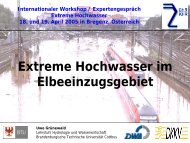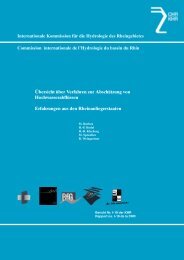ABSTRACTS 'Extreme Discharges' - CHR-KHR
ABSTRACTS 'Extreme Discharges' - CHR-KHR
ABSTRACTS 'Extreme Discharges' - CHR-KHR
Create successful ePaper yourself
Turn your PDF publications into a flip-book with our unique Google optimized e-Paper software.
Does the perception of extremity change? An ongoing case<br />
study in the Sure river basin<br />
Hugo Hellebrand<br />
G. Drogue<br />
P. Matgen<br />
C. Schmitz<br />
J. Juilleret<br />
E. Vansuypeene<br />
L Hoffmann<br />
L. Pfister<br />
Centre de Recherche Public Gabriel Lippmann<br />
Av. de la Faiencerie 162A, L 1511 Luxembourg<br />
hellebra@crpgl.lu<br />
Introduction<br />
In the last twelve years the Grand Duchy of Luxembourg experienced its three largest flood events of the<br />
past five decades, causing considerable economic damage. From the layman’s point of view this high frequency<br />
of floods seems unacceptable and gives the hydrologist to answer the following important question:<br />
did the frequency of extreme flood events change? The answer to this question lies mainly in the field of two<br />
major topics, which are presently of high interest: climate change and land use change.<br />
Concerning climate change several studies have pointed out that there is an actual change in the climate of<br />
the Rhine and Meuse basins. Pfister et al. (2004) demonstrated an increase of westerly atmospheric fluxes<br />
leading to an increase in winter rainfall duration and intensity. In another study climatological observations<br />
through the 19 th and 20 th century for the Grand Duchy of Luxembourg have shown a clear trend towards<br />
higher rainfall totals as a consequence of changes in the dominating atmospheric circulation patterns (Pfister<br />
et. al., 2004). An increase of average discharge rates and flood frequency in the Rhine during the last century<br />
has been attributed to the increase of winter rainfall (Engel, 1997). Concerning micro- and mesoscale basins<br />
in the Grand Duchy of Luxembourg the observed climate change signal of the last 50 years has had very<br />
contrasted consequences on maximum stream flow, mainly due to the orientation of the westerly fluxes and<br />
the influence of the topography (Pfister et al., 2004). However in the same study it was concluded that an<br />
increase in number of days with rainfall and/or in rainfall event duration could lead to a higher overall basin<br />
humidity, thus creating favourable conditions for high surface runoff rates.<br />
During the last century considerable changes in land use have occurred, mainly consisting in an increase in<br />
urbanisation, in a change in forest cover and in an increase in drained agricultural lands. However, no clear<br />
evidence exists of the impact of land use changes on flood frequency and magnitude in the main channels of<br />
the Rhine and Meuse basins (Pfister et al., 2004). Land use change may nevertheless have a significant impact<br />
on the hydrological behaviour in micro- or mesoscale river basins and particularly urbanisation can have<br />
significant local effects in small basins (headwaters) with respect to flooding, especially during heavy local<br />
rainstorms (Pfister et al., 2004).<br />
Another cause of discharge regime change is the straightening of the rivers by reducing the floodplain with<br />
dykes and other structures. For the Rhine and Meuse basins Ebel and Engel (1994) have evaluated the loss in<br />
floodplain areas to as much as 70% of the initial 1400 km 2 . The frequency of bank overtopping for the Geer<br />
(Belgium) increased 16 fold from 1965 to 1980 and was mainly attributed to river straightening (Mabille and<br />
Petit, 1987).<br />
The above-mentioned natural and/or anthropogenic changes in climate, land use and river morphology and<br />
their interaction make it difficult to predict changes in discharge regimes on every scale. This holds especially<br />
for extreme flood events, since they are very rare and their statistical properties are extremely difficult<br />
to determine via existing observation periods (Pfister et al., 2004). In order to point out these difficulties we<br />
tried to assess the discharge regime of the Sure river located in the Grand Duchy of Luxembourg for two<br />
different periods, one from 1870-1920 and the other from 1966-2003, at the village of Steinheim.<br />
9





